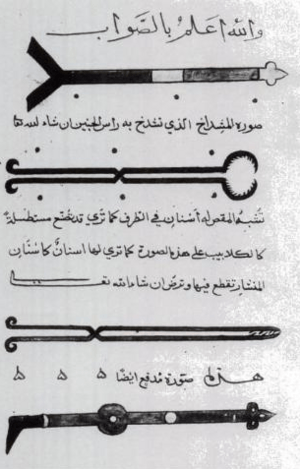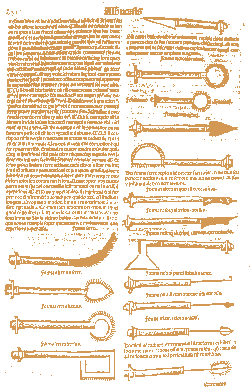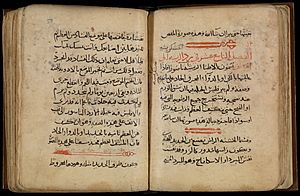Al-Tasrif facts for kids
Quick facts for kids  |
|
| Author | Abu al-Qasim al-Zahrawi |
|---|---|
| Original title | كتاب التصريف لمن عجز عن التأليف |
The Kitāb al-Taṣrīf (كتاب التصريف لمن عجز عن التأليف, meaning "The Arrangement of Medical Knowledge for One Who is Not Able to Compile a Book for Himself"), also known as The Method of Medicine, is a huge 30-volume book. It was written in Arabic around the year 1000 by a famous doctor named Abu al-Qasim al-Zahrawi, or Abulcasis. This book is like an encyclopedia about medicine and surgery.
Al-Zahrawi spent over 50 years writing the Kitab al-Tasrif. It contains lots of information about different illnesses, injuries, and how to treat them. It also describes more than 200 different tools used in surgery. Doctors and surgeons used this book for hundreds of years, even until the 1700s. Some of the surgical methods described by Al-Zahrawi are still used today! Medical students in Europe studied this book until the late 1800s.
Contents
What is the Kitāb al-Taṣrīf about?
This amazing book covers many different medical topics. These include surgery, general medicine, orthopaedics (dealing with bones and muscles), ophthalmology (eye care), and pharmacology (medicines). It also talks about nutrition, dentistry (teeth), childbirth, and pathology (studying diseases).
The most famous part of the book is its last section, which is all about surgery. Al-Zahrawi explained that he put surgery at the end because he believed it was the highest form of medicine. He thought a doctor should know about all other areas of medicine before practicing surgery.
On Surgery and Instruments: A Closer Look
The section called On Surgery and Instruments is the 30th and final part of the Kitab al-Tasrif. In this part, al-Zahrawi drew detailed pictures of each surgical tool. He also explained how to use these tools for different treatments. This made it much easier for other doctors to understand and learn.
Al-Zahrawi said that his knowledge came from two main sources. First, he carefully read many old medical books. Second, he gained a lot of experience from his own practice. He wrote that he wanted to make this knowledge easy to understand for everyone.
Al-Zahrawi wrote this section because surgery was not very advanced in the Islamic world at that time. He felt that many doctors did not understand anatomy (the study of the body's structure) or physiology (how the body works). He believed this lack of knowledge led to mistakes.
Al-Zahrawi stressed how important it was to know about the human body. He wrote:
"Before practicing surgery one should gain knowledge of anatomy and the function of organs so that he will understand their shape, connections and borders. He should become thoroughly familiar with nerves muscles bones arteries and veins. If one does not comprehend the anatomy and physiology one can commit a mistake which will result in the death of the patient. I have seen someone incise into a swelling in the neck thinking it was an abscess, when it was an aneurysm and the patient dying on the spot."
This quote shows how serious he was about doctors truly understanding the body.
New Surgical Ideas and Tools
Al-Zahrawi introduced many new surgical methods in his book. For example, he described how to crush bladder stones using a tool he called a "michaab." He also explained how to use special forceps to remove a dead fetus during childbirth.
His book also included new ideas for dentistry. He wrote about using gold and silver wires to hold loose teeth in place. He also discussed how to extract and replant teeth. Plus, he explained how to clean plaque from teeth to prevent periodontal disease (gum disease).
Al-Zahrawi drew over 200 different surgical instruments. Some of these tools he invented himself! The tools shown in al-Tasrif include different kinds of scalpels (surgical knives), retractors (tools to hold tissue aside), curettes (tools for scraping), pincers, and specula (tools to open body cavities). He also designed tools for his favorite techniques, like cauterization (burning tissue to stop bleeding) and ligature (tying off blood vessels). He even invented hooks with a double tip for surgery.
How the Book Spread to Europe
In the 12th century, a scholar named Gerard of Cremona translated al-Zahrawi's book into Latin. This made the book very popular in Europe. It became a standard textbook in important universities, like those in Salerno and Montpellier.
For the next 500 years, Kitāb al-Taṣrīf was the main source of information on surgery in Europe. A historian of medicine, Arturo Castiglioni, said that al-Zahrawi's book had the same importance for surgery as the Canon by Avicenna had for general medicine. This shows how influential Al-Zahrawi's work was.
Images for kids
See Also
 In Spanish: Al-Tasrif para niños
In Spanish: Al-Tasrif para niños





